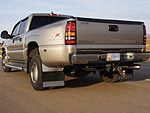
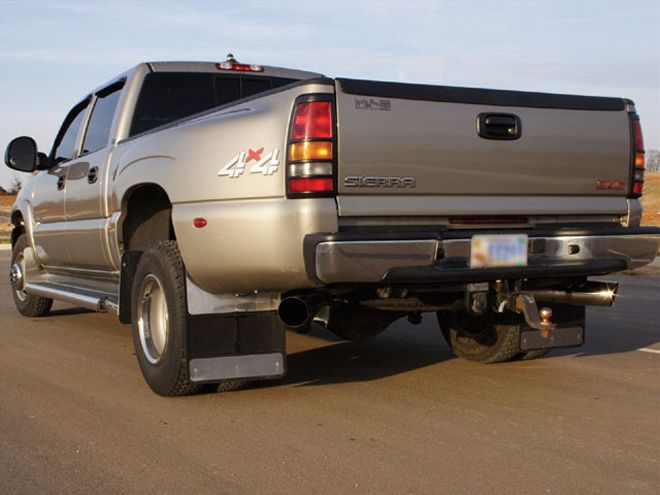 Didn't He Forget Something? Photo courtesy of Flowtech Exhaust
Didn't He Forget Something? Photo courtesy of Flowtech Exhaust
For the most part, the days of "run whatcha brung" are long gone, which means it's pretty hard to go racing without the benefit of a good tow vehicle. We've all got 'em: from F-150s to Silverados, to dualies, to the new Kenworth T660. OK, maybe we don't all have that last one, but you get the idea.
We spend so much time working on and preparing our race cars that the tow vehicle is often overlooked. But it shouldn't be. Whether you're Peter Jellen driving a Joe Gibbs Racing transporter or you're a local racer towing your Street Stock on an open trailer behind a shortbed C1500, the goal is the same-get to the track safely at the lowest possible cost. After all, if you're blowing too much cash on travel, that means less money for shocks.
With that in mind, here are 10 things that will help you increase the efficiency and safety of your tow vehicle. Most of these items are generic in nature and can be used on gas- or diesel-powered vehicles.
1.Induction Making your motor breathe better is a major key in elevating its efficiency when it comes to towing. Aftermarket air intake systems can provide better gas mileage and increased performance. There are many choices when it comes to intake systems, but they all have the common goal of carrying more clean, cool air into the intake valves. That being said, intake system manufacturers spend gobs of money researching the best pipe routing, tuning resonance properties, and so on.
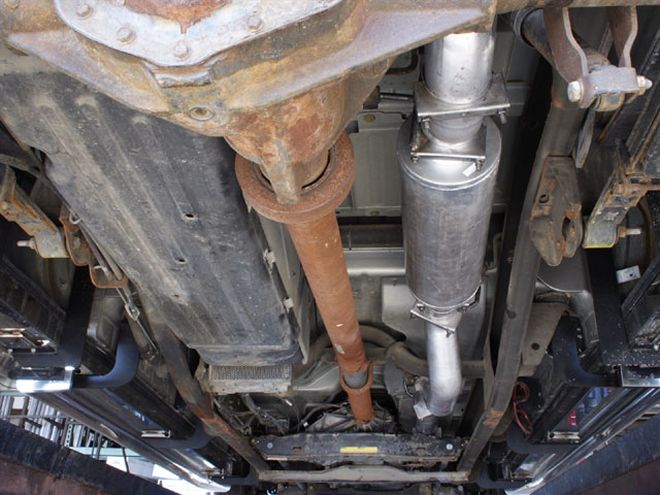 Here's an example of an after-cat system, complete with muffler, installed on a GMC Sierra. Photo courtesy of Flowtech Exhaust
Here's an example of an after-cat system, complete with muffler, installed on a GMC Sierra. Photo courtesy of Flowtech Exhaust
There are three components in an intake system: the air filter, the airbox, and the intake tube. Most manufacturers sell complete systems as well as individual components.
Let's start with the filter. Stock filters are made of paper, and aftermarket filters have gauze, foam, or synthetic media. Most are washable and reusable. Some need to be oiled while others work dry. The amount of air the filter flows is the key to getting optimum performance from an intake system. All reputable manufacturers will disclose their flow numbers. Remember, higher flow is better.
Next is the airbox. Some systems have an exposed air filter at the end of the air tube, but others use an airbox. The box systems are designed to keep out extra dirt and heat, which can rob horsepower from your truck.
Lastly, there is the intake tube, which holds everything together. There are polished tubes, powdercoated tubes, composite tubes, and more, all of which are designed to increase airflow. Arizona-based manufacturer Airaid makes a composite tube called the MIT. Airaid says the MIT flows up to 400 cfm more air than a typical factory unit. When an MIT was bolted onto an '04 Ford F-150 5.4L, the motor gained 12 more horsepower and 18 ft-lb of torque on the dyno. Not bad for a unit with an MSRP of $105.95.
Naturally, manufacturers design all three of these components to work in concert with one another, so it is a good idea to purchase complete systems. Most complete system kits bolt right up and can easily be assembled in a couple of hours. Figure a cost between $200 and $300, depending on the system and the manufacturer.
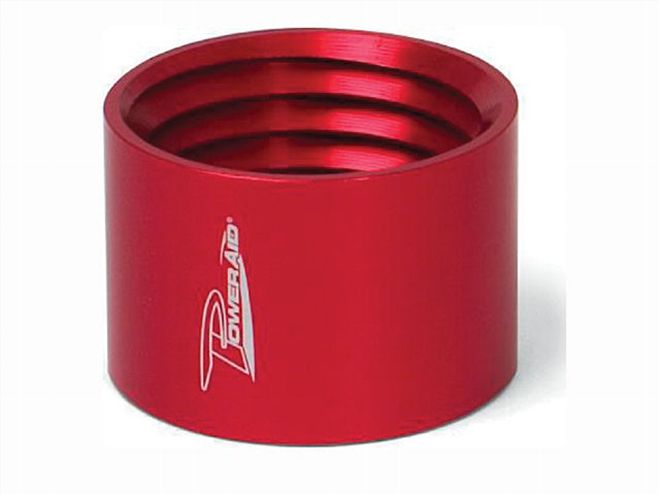 This PowerAid throttle-body spacer fits a 6.6L Duramax diesel. Photo courtesy of Airaid
This PowerAid throttle-body spacer fits a 6.6L Duramax diesel. Photo courtesy of Airaid
2. Throttle-Body Spacer While you're bolting up that new intake system, take a minute to consider adding a throttle-body spacer (TBS). A TBS works just like a carb spacer on your race car and will help enhance midrange power, torque, and fuel efficiency. Airaid makes one called the Poweraid TBS. Its dyno-tested "Helix Bore" causes the incoming air charge to spin as it passes through the throttle body and carries it all the way into the combustion chamber. The spinning action produces a super-atomized mixture, which results in midrange power and overall efficiency gains.
3. Exhaust Systems Once you've reworked the intake system, it's a great idea to take a hard look at the exhaust system. The system from the factory is more restrictive than most aftermarket products. Aftermarket exhaust systems are designed to increase exhaust flow while reducing backpressure. This, in turn, improves torque. Additionally, a well-designed system helps lower exhaust gas temperatures, which is important because high EGT can harm vital engine components.
Aftermarket exhaust systems of good quality are plentiful, but there are a few features to examine, including how the tubing is bent and welded, what it is made of, and the width of the pipes.
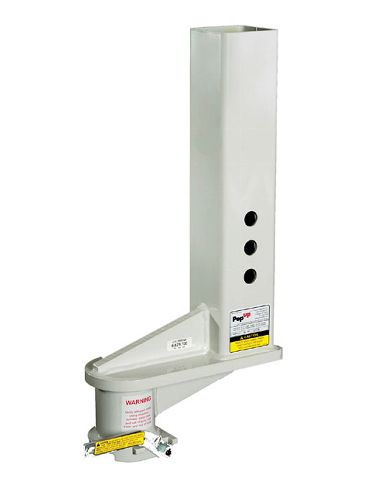 The SB2 extended coupler makes towing much easier and safer. Photo courtesy of Popup Industries
The SB2 extended coupler makes towing much easier and safer. Photo courtesy of Popup Industries
Flowtech, a division of Holley, makes a complete after-cat system for a wide range of diesel truck models that fits those requirements more than satisfactorily. It's made from sturdy, 16-gauge, aluminized steel, which resists corrosion. All of the tubing is mandrel-bent, ensuring smooth exhaust flow, and the system is robotically welded, which virtually guarantees leak-free construction. The systems are big, too, featuring a 4-inch tube. That's important because size is a major way that manufacturers get these systems to breathe better.
A single inlet/outlet system with muffler (Flowtech PN 62451FLT) will run you about $400. Regardless of who you choose to go with, you should always look for a system that comes complete with all the components (clamps, hardware, hangers, and tips) necessary for installation. It'll make your life a lot easier.
Once you have a monster exhaust system on your truck, the next logical step is to bolt up a new set of headers. I've always been a fan of buying headers and exhaust systems from the same manufacturer. Generally speaking, you are assured of having the same quality in both, and the systems are often designed together to maximize horsepower, flow, and other efficiencies. With that in mind, Flowtech also offers emissions-friendly headers that will further boost your power and performance. Like the after-cat systems, these headers can be bolted on and retain all stock emissions equipment. A set of painted steel headers costs about $250 depending upon make, model, engine size, and so on.
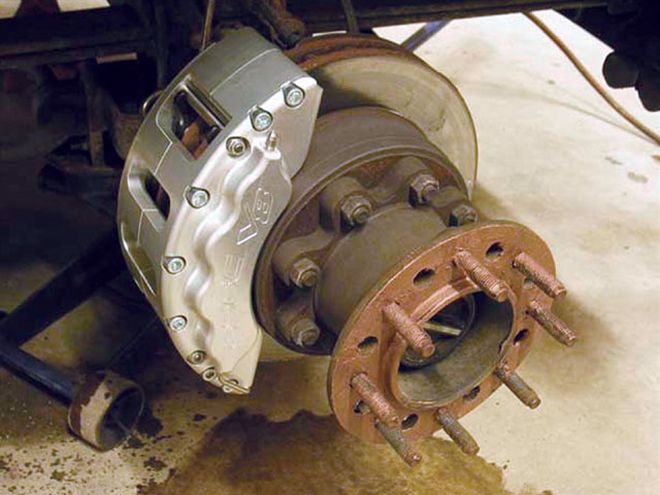 SSBC's Quick Change Force 10 calipers installed on an '02 Ford F-350. Muscle Mustangs and Fast Fords Archive
SSBC's Quick Change Force 10 calipers installed on an '02 Ford F-350. Muscle Mustangs and Fast Fords Archive
This is a big one. Now that you've got a hot induction system and beefed-up exhaust, you need to be sure you can stop all that extra power. While the towing packages on many of today's trucks include heavy-duty brakes, you can upgrade your brakes even further for under $2,000. The added safety benefits and better braking performance are worth the money. Think of all the money you spend on your race car. The last thing you want to have happen is an accident caused by your inability to stop your truck in time.
Stainless Steel Brakes Corporation (SSBC) makes a wide range of upgraded braking systems for trucks. But our friends at Muscle Mustangs and Fast Fords (a sister publication to Circle Track) did a caliper swap on their '02 F-350, which they use for towing their drag cars around in a 45-foot, fifth-wheel trailer. They used SSBC's Quick Change Force 10 V-8 brake calipers, which are designed to improve braking by simply replacing existing calipers on any '99-'04 F-250 or F-350 (2WD or 4WD) Super Duty truck.
The kit includes two eight-piston aluminum calipers that bolt directly to the stock location. Having four pistons per side allows an even distribution of pressure to the pads. The extra length of the pads provides more contact area and better overall braking power. The net result is less pedal effort needed to stop, and you can also reduce the gain on the trailer brakes.
The retail price of the SSBC kit is $1,695, and it can be installed in an afternoon. That's a small price to pay for added safety, better braking, and more confidence behind the wheel.
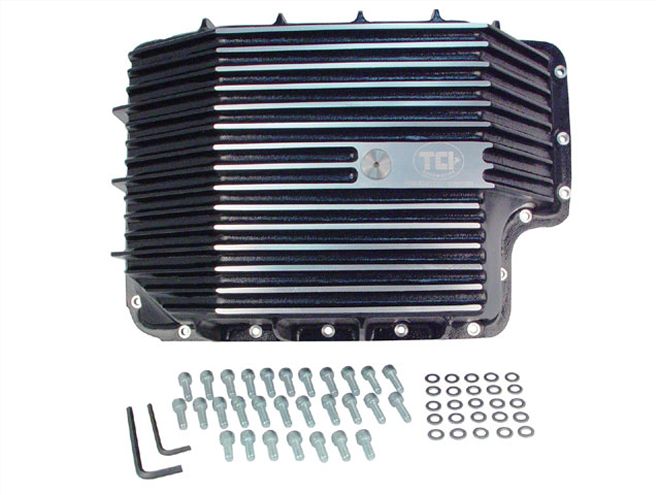 A deep aluminum pan like this one from TCI holds more fluid and dissipates heat better than factory pans. Photo courtesy of TCI Transmissions
A deep aluminum pan like this one from TCI holds more fluid and dissipates heat better than factory pans. Photo courtesy of TCI Transmissions
Your transmission could possibly be one of the most abused parts of your truck when it comes to towing. The heat generated in the transmission when towing heavy loads dramatically reduces the life span of its parts. Couple that with the fact that today's transmissions are so technologically advanced (read: expensive to fix) and you have the potential for big problems if you don't treat your tranny with a little TLC.
Anything you can do to get the operating temperature down will significantly help efficiency and longevity. So we asked Scott Miller at TCI Transmissions for a few tips on how to reduce the temperature, and he provided the following projects, which you can accomplish in less than four hours.
Tip 1 Change your transmission fluid. "A high-performance or even a racing transmission fluid can have a dramatic effect on the operating temperature of your transmission," says Miller. TCI manufactures a trans fluid called "Max Shift RTF," which Miller says can drop the operating temp of your tranny a full 30 degrees. A fluid swap is especially beneficial for older vehicles with high mileage. But there is one caution: Max Shift RTF, or any aftermarket tranny fluid for that matter, will not work in certain newer-model transmissions, such as post-'04 Fords and the '07 Dodge Cummins. For those units, you must use the factory-recommended fluid.
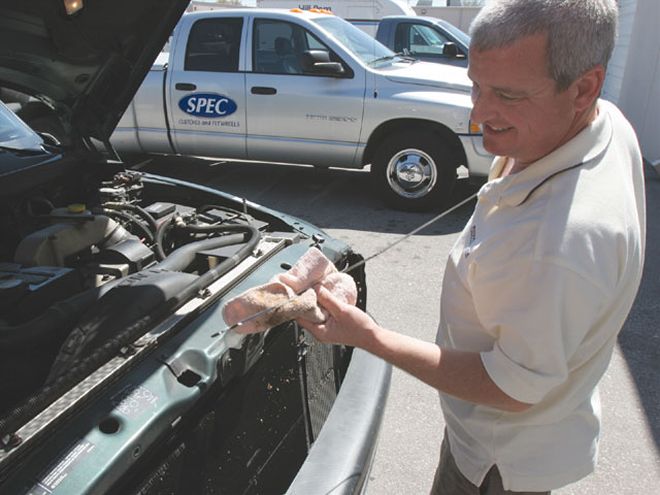 Checking and changing your oil: It is one of the easiest and most important things you can do to keep your truck running efficiently. Photo by Patrick Hill
Checking and changing your oil: It is one of the easiest and most important things you can do to keep your truck running efficiently. Photo by Patrick Hill
Tip 2 Swap out to a deep aluminum pan. Aluminum dissipates heat much better than the factory steel that came with the truck. In addition, the deep pan will hold approximately 7.5 extra quarts of fluid. All of that extra fluid will further help to keep your transmission cool. How cool? "One of our guys here has a 2004 F-250. He put a pan on it, and the temperature dropped 20 degrees," says Miller. "That's just the pan with the factory fluid, nothing else."
Most TCI aluminum pans have an O-ring seal and don't use a gasket, making the 2-3-hour installation even easier. The cost runs between $325 and $400, depending upon your make and model. They have a wide variety of pans for both newer and older model transmissions.
Tip 3 Add an external transmission cooler. Your truck probably already has one, but swapping out to a bigger, beefier unit will get you more cooling efficiency. Now, if you already have a heifer of a unit, Miller suggests adding a second one. "A second one?" we asked. "Yes," he answered. Remember, the goal here is to get the tranny-operating temperature as low as possible. So every little bit helps.
Being able to maneuver a 21-foot-long, 10,000-plus-pound race trailer with a shortbed truck can be challenging, to say the least. Your hitch, how it is attached to your tow vehicle, and how it fits with your trailer are three critical items not to be overlooked. One way you can make your life a lot easier is to invest in an extended coupler.
Extended couplers replace the stock couplers and provide extra length between your truck and the trailer. That added length decreases turning radius and will enable you to maneuver in tight pit areas, parking lots, and your driveway.
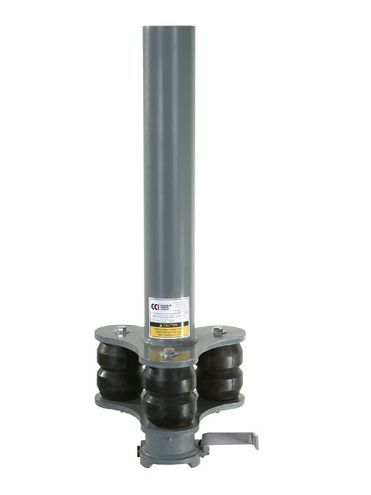
Reasonably new to racing, PopUp Industries manufactures a number of different extended couplers. Its SB series adds a full 9-inch offset to the distance between truck and trailer, which gives more trailer swing and a tighter turning radius. The unit can handle 24,000 gross trailer weight and makes hookups a piece of cake. Regardless of the type of truck you have, but especially if it's a shortbed, one of these couplers will give you a lot more turning ability, which will make your towing life much easier.
PopUp also makes extended cushion couplers for gooseneck applications. They feature a cushioning system that absorbs up to 59 percent of the bumps, jolts, and jars that make towing hard on you and your truck. In addition, the company's new fifth-wheel extended kingpin moves the kingpin 10 inches forward and yields the same towing benefits as the SB series: a tighter turning radius, more trailer swing, and easier towing.
One of the cheapest things you can do for your truck, regardless of whether it is gas or diesel, is routine maintenance. This entails changing the oil and filters, greasing the chassis, and so on. But first things first-make sure that you follow your OEM recommendations when it comes to these items. For oil changes, that's about every 5,000 miles if you're a racer towing heavy loads.
We talked with Stede Granger, OEM technical manager for Shell Lubricants, and he had some great points. If your truck sits for any period of time during the off-season, you should automatically change the oil before you start doing any towing. "When a diesel sits for an extended time, condensation can form, and you do not want any moisture in the oil," says Granger.
Remember, diesel engines carry about a $5,000 premium over gas. For that five grand, you get a precision-tuned motor that sports extremely high compression ratios. So, to keep your diesel in good working order, don't take any shortcuts.
Diesel engines require a specific oil formulation: API CJ4, or CI4+ with an SAE viscosity grade of 15W-40. Granger says you should use a well-known brand with the right mix of additives. Those additives include a high level of detergents that will keep all the internal components of the motor clean. Dispersant additives keep fuel soot very finely dispersed and prevent the particles from agglomerating. When those particles agglomerate, they come together to form deposits. Those deposits will lead to premature parts wear and other problems.
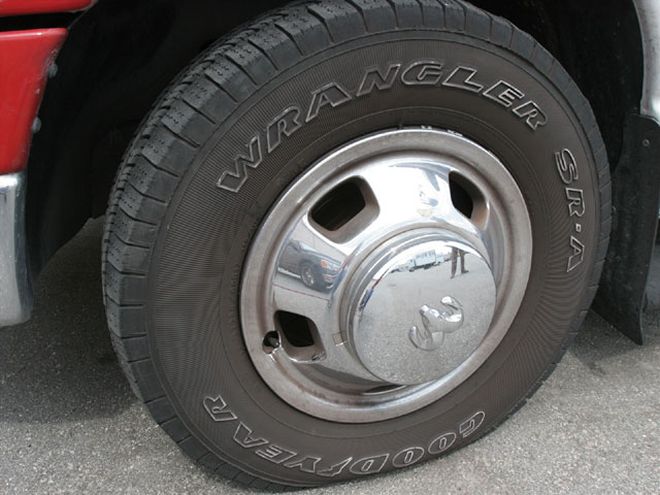 Duh, this is not a properly inflated tire. Photo by Patrick Hill
Duh, this is not a properly inflated tire. Photo by Patrick Hill
Good diesel oil, such as Shell's Rotella T, Brad Penn's multigrade diesel, or Sunoco's SuperC, has antioxidants (which prevent corrosion), antiwear additives, antifoaming additives, and a multigrade additive that will prevent the oil from experiencing premature breakdown when it is put under high shear.
In a nutshell, diesel motor oils are much more heavy-duty than motor oils for gas engines. It sounds simple enough, but make sure you're using oil made for a diesel in your diesel and oil made for gas in your gas motor.
When you change the oil, don't forget to check the air filter. Diesel engines are unthrottled, so they take in a lot more air through the air filter; that's an opportunity to accumulate a lot more debris. A dirty air filter can wreak havoc on the engine because it allows debris to move past it.
"I've seen piston rings get worn out in a very short time because the air system was dirty," says Granger. "So it is very important to make sure that air system doesn't get overwhelmed. The same goes for the fuel filter; always keep that clean and ensure that it doesn't get overwhelmed."
Oil changes as well as oil, air, and fuel filtration are all critical to keeping your racing program on the road to success.
This may seem almost as obvious as the oil change, but when you come right down to it, improperly inflated tires can cost you lots of money. Beyond blowing a tire and having to replace it, or worse, blowing a tire and having an accident, improperly inflated tires cost you money at the gas pump. Studies indicate that keeping your tires properly inflated can improve gas mileage by more than $1.50 every time you fill your tank. If you gas up once a week, that's $78 each year. You pay so much attention to the tire pressures on the race car, you should not forget to maintain the proper tire pressure on your truck and trailer, too. While you're at it, make sure the tires are properly balanced, the vehicle is aligned, and the tires are rotated periodically for even wear. It's money back in your pocket.
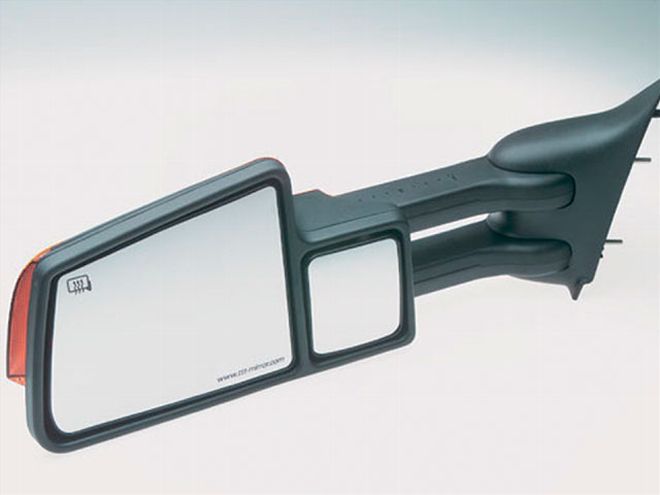 Photo courtesy of Schefenacker
Photo courtesy of Schefenacker
Lastly, here's another one of those often-forgotten items that you may want to consider: towing mirrors. Like proper tire inflation, having the right mirror is a key to towing safely. Towing mirrors provide wider visibility and definitely make seeing what is on either side of you much easier. Generally, they are easy to install and run the gamut when it comes to options. You can get mirrors that simply slide over or clip onto your existing mirrors for under $20. Or you can go all the way up to a $400-plus set, such as the Telescopic Trailer Tow Mirror made by Schefenacker (pictured below). This mirror sports interchangeable covers, built-in turn signals, and a separate, wide-view, adjustable spotter mirror.
Whatever style and price range you choose, they're an important item to have on your truck. Remember, you can't avoid what you can't see.
If you're an astute reader (and we know you are), you probably noticed something missing in this top 10 list. While we talked about induction, exhaust, and oil changes, we largely ignored the internal engine itself. That is a subject for another story, so naturally, we are going to write one. Keep an eye out, as we are going to put several different computer tuning tools, as well as other upgrades, to the test. We'll bolt them up to Don Parrish's truck and then head to the dyno to see what kind of gains we can make. We haven't told Don yet, so don't say anything, OK?